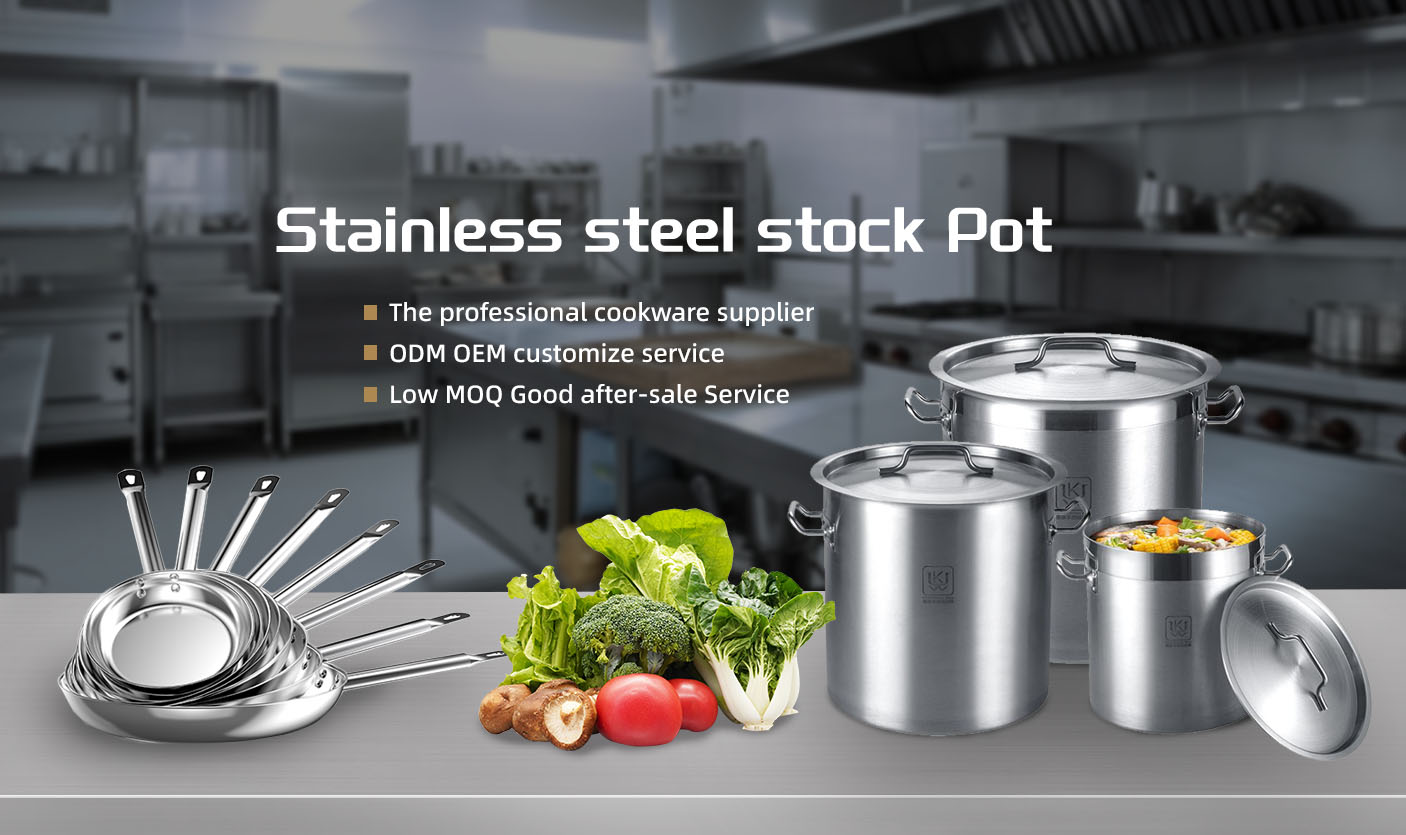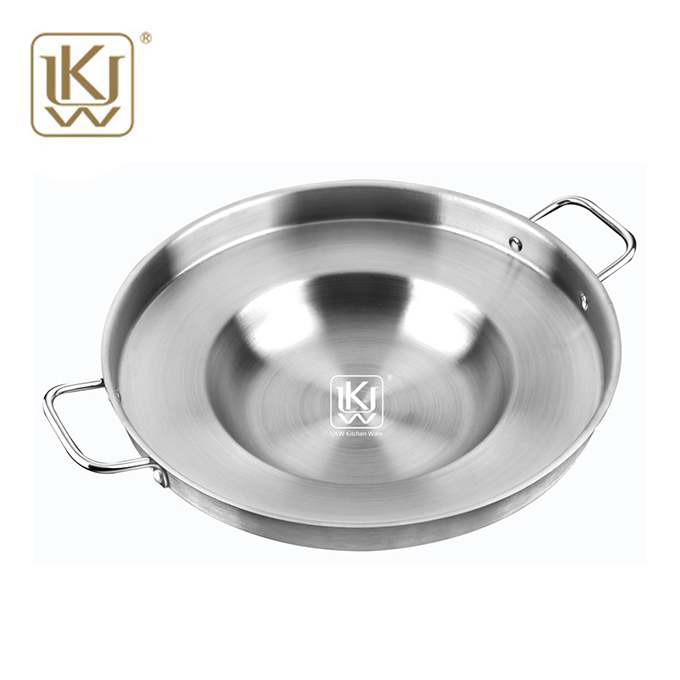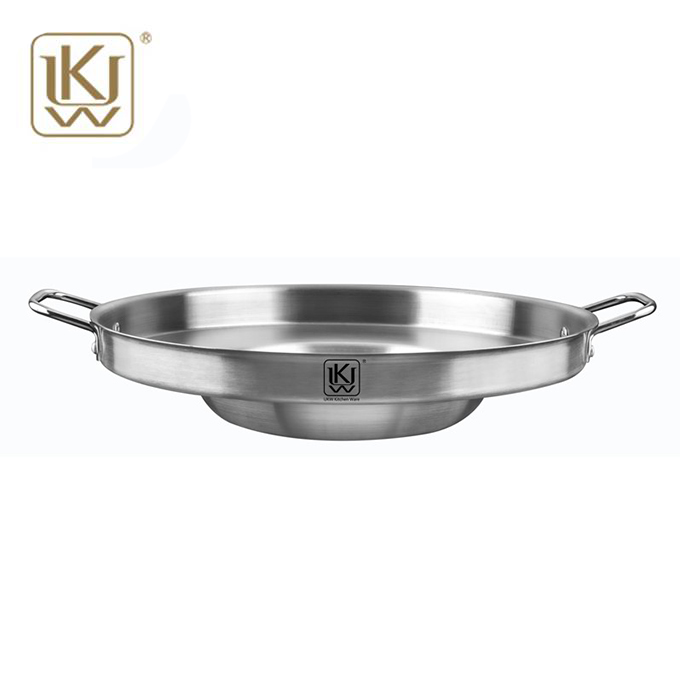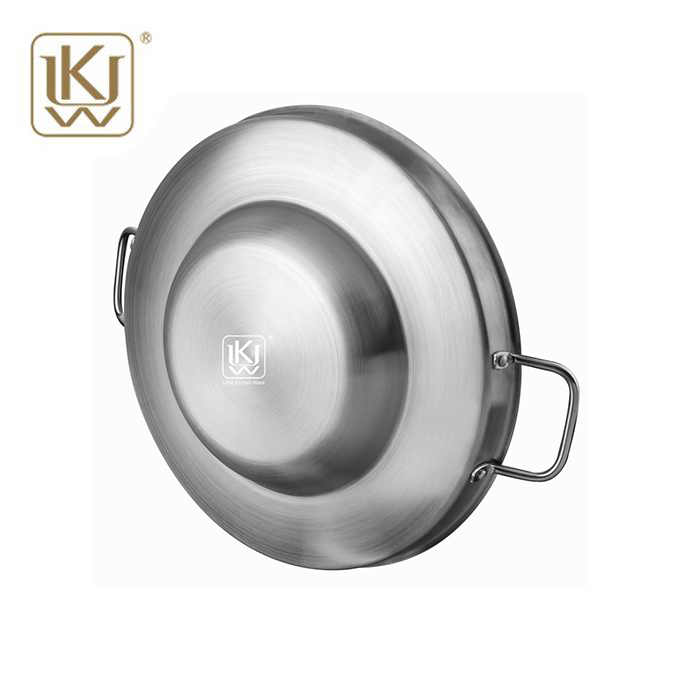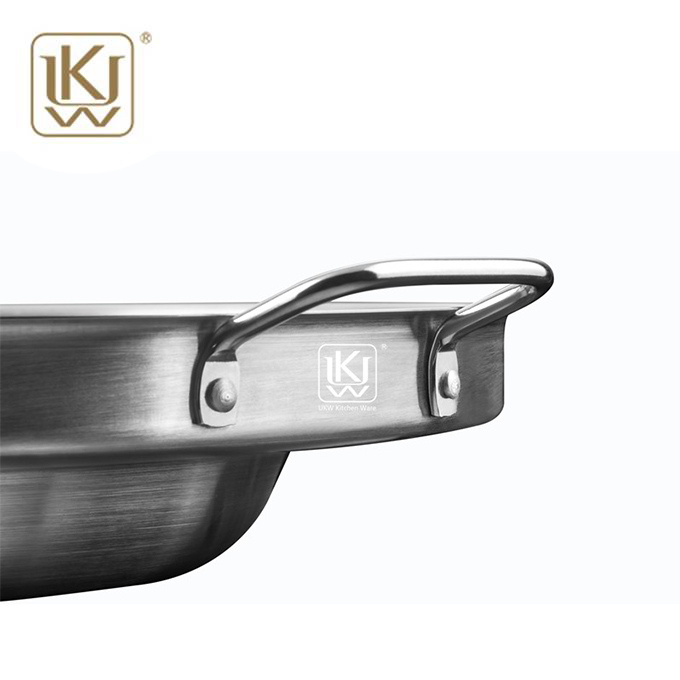Stainless Steel Concave Bottom Pan
- Product Information
Concave Bottom Pan is a pan with a concave bottom. The pan is silvery white, made of stainless steel, and has two symmetrical metal handles. The inner bottom of the pan is concave towards the center, forming a concave surface. This unique concave bottom design distinguishes it from common pans. It comes in a variety of sizes and heights to suit different cooking needs and heating equipment such as stoves.
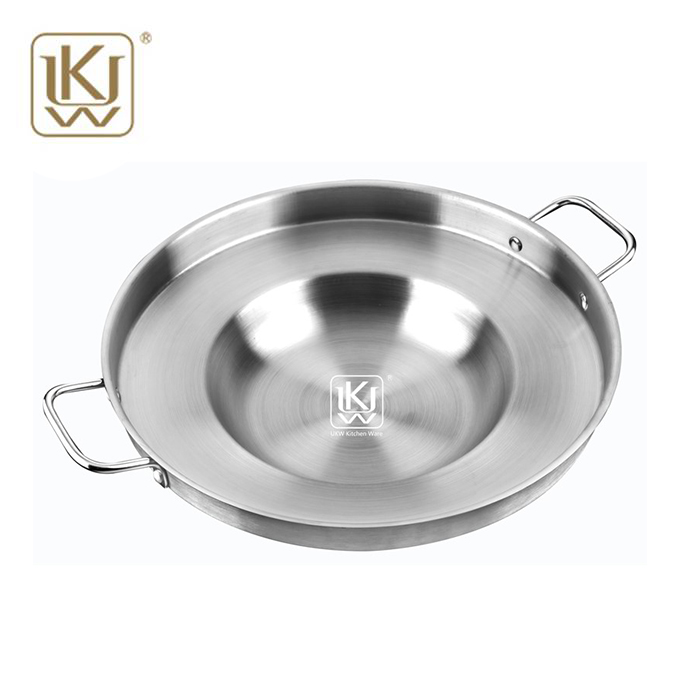
Concave Bottom Pan Parameters:
| CODE | Dimension(mm) | Thick(mm) |
| CD40040 | Ф400*H90 | 1.2 |
| CD57030 | Ф570*H105 | 1.2 |
| CD57040 | Ф570*H115 | 1.2 |
| CD57050 | Ф570*H125 | 1.2 |
| CD57060 | Ф570*H135 | 1.2 |
Concave Bottom Pan Features:
Solid and durable: The Concave Bottom Pan is made of stainless steel with a thickness of 1.2 mm. The tensile strength of stainless steel can reach 500-1000 MPa, and the yield strength is between 200-500 MPa. This high strength makes it less likely to deform or break when subjected to heavy objects and frequent use. For example, when quickly stir-frying ingredients or stirring vigorously with a spatula, the pan can still maintain a stable shape to ensure a long service life.
Good thermal conductivity: The thermal conductivity of stainless steel is about 16-20 W/(m・K), and the thickness of the Concave Bottom Pan is 1.2 mm, which means that heat energy can be quickly transferred to all parts of the pan. When heated on the stove, the heat can be evenly distributed on the concave bottom and the wall of the pan, so that the ingredients are heated evenly. For example, when frying fish, all parts of the fish body can be heated at the same time, reducing local scorching and ensuring the cooking effect.
Precise size: Concave Bottom Pan is available in a variety of specifications, such as CD40040 with a diameter of 400 mm and a height of 90 mm; CD57030 with a diameter of 570 mm and a height of 105 mm. This precise size design can meet different stove sizes and cooking needs. In commercial kitchens, you can choose the right pot according to the batch size of dishes and the size of the stove to ensure cooking efficiency and quality; in home kitchens, small models are suitable for frying eggs, and large models are suitable for frying steaks and other large ingredients.
Lightweight and easy to hold: Although the Concave Bottom Pan is large in size, the thickness of stainless steel is 1.2 mm, and the overall weight is relatively light. Taking the 570 mm diameter model as an example, the weight is usually around 2-3 kg. With two metal handles, the connection between the handle and the pot body has been reinforced to withstand the weight of the pot body and a certain amount of external force. When pouring hot oil or stir-frying ingredients, it can be easily lifted and operated stably to reduce the burden of cooking.
Not easy to rust: The stainless steel material of Concave Bottom Pan usually contains more than 10.5% chromium. Chromium can form a dense chromium oxide film on the surface, which can effectively isolate oxygen and moisture and prevent the pot from direct contact with corrosive substances. Even if it is used for a long time in a humid kitchen environment, or frequently in contact with acidic ingredients such as ketchup, lemon juice, etc., as long as it is cleaned and dried in time, it can keep the appearance bright and new, avoiding damage to the pot or food safety problems caused by rust.
Smooth inner wall: The inner wall of Concave Bottom Pan is finely polished, and the surface roughness value is low, usually between Ra0.4 - 0.8 μm. This smooth surface allows the ingredients to slide smoothly in the pot, reducing the risk of sticking to the pot. When cooking, the ingredients can be easily stir-fried and it is not easy to leave residue; when frying meat, the gravy is not easy to adhere to the pot wall. Even if there is a small amount of residue, it can be removed by wiping it lightly with a damp cloth, which greatly reduces the difficulty of cleaning.
Reasonable handle design: The two metal handles of Concave Bottom Pan are reasonably designed and installed at the widest part of the two sides of the pot body. When using it, you can hold the handles by letting your hands hang naturally, which conforms to the principle of ergonomics. The handle surface is smooth, will not scratch the skin, and is firmly connected to the pot body. It can provide stable support when picking up or putting down the pot. Whether it is the heavy state of full ingredients or the high temperature of the empty pot after heating, it can be operated safely to prevent burns or the pot from slipping.
Applicable to multiple heat sources: The stainless steel material and bottom design of Concave Bottom Pan make it compatible with multiple heat sources. On the gas stove, the concave bottom can fully contact with the flame to ensure thermal efficiency; on the induction cooker, the stainless steel material can effectively induce the electromagnetic field to generate heat. After testing, when heated on the induction cooker, the temperature of the bottom of the pot can rise to 180-200℃ within 3-5 minutes, meeting the needs of frying and cooking, adapting to the heat source conditions of different kitchens, and broadening the scope of use.
Concave Bottom Pan Application:
Home kitchen: Concave Bottom Pan can be used in many scenarios of daily home cooking. Due to its concave bottom design and good thermal conductivity, it is particularly suitable for frying various ingredients, such as steak, fish, and eggs. During the frying process, the concave bottom shape can heat the ingredients evenly, better lock the moisture and nutrition of the ingredients, and also form a delicious crispy surface layer. In addition, it can also be used for stir-frying. Its large bottom area and easy stir-frying characteristics can meet the needs of stir-frying various vegetables, meat and other ingredients in daily home cooking, allowing housewives or cooking enthusiasts to easily make delicious dishes.
Catering industry: This pot is also widely used in restaurants, hotels and other catering places. For some dishes that need to be quickly stir-fried and fried, such as stir-fried dishes in Chinese cooking and Western fried meat, Concave Bottom Pan can efficiently complete the cooking task. Its precise size and good thermal conductivity ensure the quality and taste consistency of the dishes, meeting the high requirements of the catering industry for dish quality and cooking efficiency. At the same time, due to its characteristics of not easy to rust and easy to clean, it is also convenient for daily cleaning and maintenance of catering places, which meets the hygiene standards of the catering industry.
Cooking training school: Cooking training schools can use Concave Bottom Pan as one of the teaching tools. Because it has models of various sizes and heights, it is suitable for cooking courses at different stages. During the teaching process, students can use the pot to practice various cooking techniques, such as frying, stir-frying, boiling, etc., learn how to control the heat, master the heating conditions of ingredients, and perform operations such as stir-frying. Its stable performance and good thermal conductivity help students better understand and master cooking skills, improve learning effects, and cultivate more cooking professionals.
Outdoor barbecue activities: Concave Bottom Pan can also play a role in outdoor barbecues. It can be placed on the grill and used to fry ingredients such as steaks and hamburger patties. The concave bottom design enables the pot to better contact the fire of the grill to achieve uniform heating. Even under outdoor cooking conditions, it can produce barbecue foods with golden color, delicious taste and uniform doneness, adding more gourmet experience to outdoor barbecue activities. At the same time, its light and easy-to-hold features make it easy to carry and use, allowing people to enjoy the fun of cooking outdoors.
Food processing companies: Food processing companies also use Concave Bottom Pan when making some semi-finished or finished foods. For example, when making some prepared meat products or pre-packaged foods, frying or stir-frying is required. The large bottom area and good thermal conductivity of the pot can meet the needs of batch processing and improve production efficiency. Moreover, its easy-to-clean characteristics make it easy to maintain hygiene during food processing, meet the strict hygiene requirements of food processing companies, and ensure food safety and quality.
Creative cooking for cooking enthusiasts: For cooking enthusiasts, Concave Bottom Pan is a good helper for creative cooking. Its unique concave bottom shape and stainless steel material provide more room for cooking enthusiasts. They can use the pot to try various novel cooking methods, such as adding liquid to the pot for low-temperature slow cooking, using the concave bottom shape to stack ingredients for cooking, etc., to create unique food works, satisfy personal pursuit of cooking creativity, and also enrich food culture.
Concave Bottom Pan Maintenance:
Cleaning after use: After cooking food with the Concave Bottom Pan, let the pan cool down for a while to avoid overheating and burns when cleaning. Then add an appropriate amount of warm water to the pan, use a soft sponge or cleaning cloth, add a few drops of mild detergent, and gently wipe the inner wall and concave bottom of the pan to remove residual ingredients and stains. For more stubborn stains, you can increase the friction of the cleaning cloth appropriately, but be careful to avoid using rough cleaning tools such as steel wool to avoid scratching the surface of the pan. After cleaning, rinse with clean water to ensure that there is no residual detergent, and then wipe the water inside and outside the pan with a clean soft cloth to avoid rust caused by residual water stains.
Regular deep cleaning: It is recommended to deep clean the Concave Bottom Pan once in a while. You can soak the pot in a container filled with warm water and an appropriate amount of baking soda for 10-15 minutes. Baking soda has a certain decontamination and deodorizing effect, which can effectively remove stubborn stains and odors generated by long-term use of pots. After soaking, use a soft brush to gently scrub the inside and bottom of the pot, especially some hard-to-reach corners and gaps. After scrubbing, rinse again with clean water and dry thoroughly. The frequency of deep cleaning can be determined according to the frequency of use of the pot. It is generally recommended to do it once every 1-2 weeks.
Avoid dry burning: When using Concave Bottom Pan, be sure to avoid dry burning. Dry burning will cause the temperature of the pot to rise sharply, causing changes in the stainless steel material, which may cause the pot to deform, damage, and even produce harmful substances, affecting food safety. Before heating the pot, make sure there is enough food or liquid in the pot, such as oil, water, etc., to ensure the safety of the pot during use. If dry burning occurs accidentally, turn off the fire immediately and let the pot cool naturally. Do not pour cold water into the pot immediately to avoid damage to the pot due to excessive temperature difference.
Reasonable storage: When the Concave Bottom Pan is not in use, it should be stored in a dry and ventilated place. The pot can be placed in the kitchen cabinet or a special pot storage rack, and make sure there is no residual moisture or food residue in the pot. In order to avoid scratches or damage caused by collision between the pot and other hard objects, soft cloth or partitions can be placed between the pots for isolation during storage. If the pot is not used for a long time, a thin layer of cooking oil can be applied to the surface of the pot to prevent rust, but be sure to wrap the pot with plastic wrap or other materials to prevent dust and impurities from entering.
Correct use of detergent: When cleaning the Concave Bottom Pan, choose a detergent suitable for stainless steel. Avoid using strong acidic or alkaline detergents, as these detergents may corrode the surface of stainless steel, destroy its corrosion resistance, and thus shorten the service life of the pot. If there are some slight scale or stains on the surface of the pot, you can use a special stainless steel cleaner, clean it according to the product instructions, then rinse it with clean water and wipe it dry. In addition, be careful not to leave the cleaner on the surface of the pot for a long time, and rinse it in time after cleaning.
Check the condition of the pot regularly: In order to ensure the normal use of the Concave Bottom Pan and extend its service life, the condition of the pot should be checked regularly. Check whether there are any abnormalities such as scratches, dents, rust, etc. on the surface of the pot. If slight scratches or dents are found, you can use stainless steel polish to repair them, but be careful to follow the instructions for use of the polish to avoid further damage to the pot. If rust is found, it should be treated with rust remover immediately, and a layer of cooking oil should be applied after treatment for maintenance. At the same time, check whether the handle of the pot is firm and whether the screws are loose. If there are any problems, they should be repaired or replaced in time to ensure safe use.


